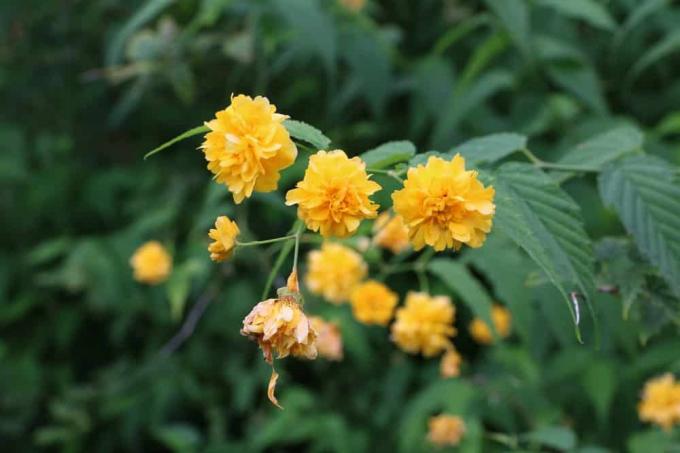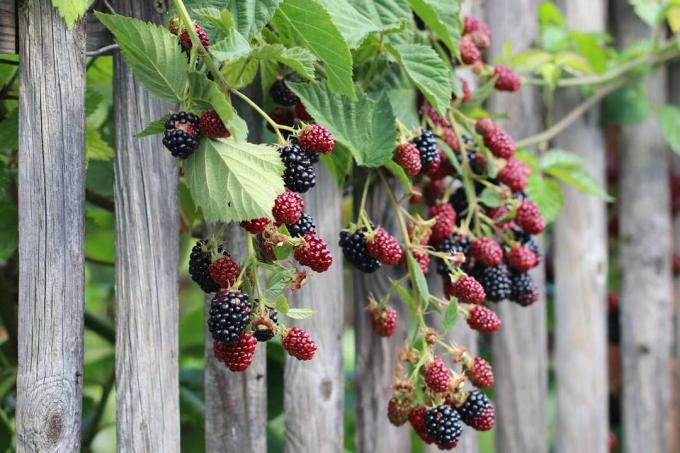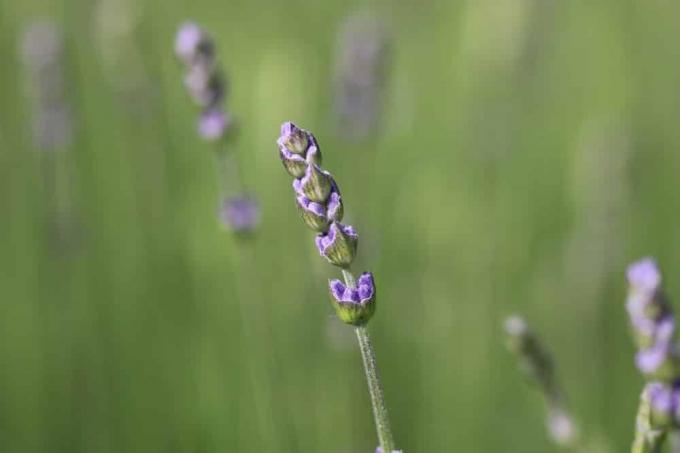

Table of contents
- When is the best time to prune the ranunculus bush?
- When and how is the ranunculus bush cut?
- types of pruning
- thinning cut
- taper cut
- hedge trimming
- vase cut
- When is the right time for a hedge trimming?
- How does the cut have to be done step by step?
- The right tool
- What mistakes should you avoid?
- Should you cut off faded flowers?
The Raununculus is originally native to Japan and China. It impresses with its overhanging branches and early abundance of flowers. In order to thrive, it needs a semi-shady spot with normal garden soil. If it is well cared for and pruned, it will permanently rejuvenate itself with new shoots and will be an eye-catcher in the garden for years. A filled ranunculus bush is particularly impressive, which attracts the viewer's attention with yellow flower balls.
When is the best time to prune the ranunculus bush?
The best time to cut a goldrose is late spring. Shortly after flowering, old, lignified and diseased branches can be removed just above the ground. With this intervention, the bush will be rejuvenated. From the remaining branch stump, new shoots grow out of the "sleeping eyes", which then bear flowers next spring. Ideally, the shrub will flower a second time in autumn. After that, it can be thinned out again if necessary.
When and how is the ranunculus bush cut?
A radical pruning is not recommended for the gold rose. If all the shoots are shortened at once, the lower part of the shrub will bare after a while. On the other hand, regular but moderate pruning of the older branches (older than two years) shortly after flowering stimulates the plant to form new shoots. This care measure keeps the shrub young and strong.
A topiary is also not suitable for the ranunculus bush. If its graceful, drooping branches are forced into an unnatural shape, the overall appearance of the shrub suffers. The willingness to flower will decrease, since the young branches bearing flowers will also be removed or shortened too much.
Tip:
When thinning out, cut off the corresponding branches directly at the base.
types of pruning
When cutting ranunculus, there are these cutting options:
thinning cut

Immediately after flowering, on a dry day with little sun, the simple and a double ranunculus bush are carefully pruned. This is a clearing cut. Branches older than two years, as well as diseased and crossing shoots are removed. Withered flowers can also be cut off to encourage the shrub to bloom again in the fall.
taper cut
If the ranunculus bush has not been cut for years, the plant will age. The lower areas are very woody, have few leaves and only a few flowers appear on the hanging branches. Then at the latest it is time for a rejuvenation cut or radical cut. The plant is radically shortened so that new shoots can develop from the "sleeping eyes" of the branch stumps just above the ground.
The optimal time for a rejuvenation cut is a frost-free period in January or February. Now you can radically cut the old and lignified branches. Diseased and inward-growing wood is also rigorously cut.
The golden rose will look bare and plucked for a relatively long time, because the shrub needs a few months to recover from the radical pruning measure carried out. It is therefore much better for the shrub and also for the overall picture of the garden to take the time for regular and gentle thinning.
hedge trimming
The simple ranunculus bush as well as a double ranunculus bush are suitable as an impressive solitary plant, but also for planting a flowering hedge. This should be able to grow freely and not be cut into a special shape. However, you need sufficient space for a free-growing hedge.
vase cut
The golden yellow flowers of the ranunculus bush bring the right spring mood to your garden every year. Immediately after the buds have blossomed, cut a few stems for the vase and bring the sun into your home. The shrub doesn't mind such small cuts.
Tip:
Leave about 10 cm of the branch. At the interface, the gold rose will quickly sprout again.
When is the right time for a hedge trimming?
In order for the golden rose in a hedge to keep its shape and not grow uncontrollably, it needs to be cut twice a year. For the first time, as with a solitary shrub, the old and diseased branches are removed in early spring and overly long shoots are shortened. You should move the second cutting date to autumn. With buds already developing for spring blooms now, only overhanging branches need pruning.
Cut to avoid overgrowth
It is in the nature of the ranunculus shrub to spread vigorously and take up as much space as possible. For this, the plant forms permanent foothills, which must be cut to avoid uncontrolled growth.
Tip:
Bring a root barrier into the planting hole when planting the golden rose. This will prevent you from spreading unhindered.
How does the cut have to be done step by step?

If the gardener wants to cut his ranunculus properly, there are a few rules to follow. This is the only way for the shrub to retain its natural shape and form its magnificent abundance of flowers year after year.
old wood
Old shoots have brown bark. Here no more buds develop in the upper areas. Therefore, these branches are cut about ten centimeters above the ground. New shoots can now sprout from the "sleeping eyes" in the stump, which will then also bear flowers again.
young wood
Young shoots can be recognized by their fresh, green bark. If they have grown too long and cover other trees, they can be shortened to the desired length, but no more than a third. The cut is made just above a leaf node. This is where new branches develop, which then also bear flowers again.
The right tool
Good quality tools are required for pruning trees and shrubs. The blades must be sharp and above all clean. To avoid germs or fungal spores getting into the cuts on the branch, clean your tools with alcohol before starting work.
The bypass secateurs
These are one-handed scissors, the blade and counter-blade are made of hardened steel. When cutting, you get a smooth cut surface on the branch, which closes quickly and does not allow bacteria or viruses to penetrate.
The anvil secateurs
Here a sharp blade meets a smooth surface. When cutting, you press the branch onto the surface and cut through it in this way. The branch suffers bruises. Cracks appear in the wood and the cut surface becomes frayed. This is where germs can penetrate and cause considerable damage to the shrub. Therefore, these scissors are not suitable for cutting delicate branches.
What mistakes should you avoid?

The ranunculus shrub is a robust representative of its kind. Beginners in pruning don't have to worry about doing something wrong. There is no special pruning technique for this shrub. If you cut off too much or cut too deep, there will be no permanent damage. The shrub regenerates and quickly sprout again.
Should you cut off faded flowers?
When the flowers of the ranunculus wither, small seeds emerge. These contain glycosides, which lead to nausea and vomiting when consumed in large quantities. If there are children or animals in the household, you must therefore remove the withered flowers immediately to avoid possible poisoning.
 Home editorial office
Home editorial office
Learn more about pruning

Eucalyptus dried up: cut back now?
When a eucalyptus dries up, some owners immediately think of cutting it back. Because they want to see fresh green bud quickly. The chances of that happening may be good. But one thing must not be left out: research into the causes! Otherwise a new cycle of drying up and cutting begins.

Cut blackberries: Instructions for the right cut
Bramble branches only bear fruit for one summer, after which they are used up and die off in winter. It's a good thing that new canes grow back in time for the following year. Cutting care means: What no longer supports should be removed, young rods must be optimally trained.

cutting snowball | 13 tips for pruning
When it comes to snowballs (Viburnum), the opinions of numerous hobby gardeners differ when it comes to cutting. Main reason against pruning: Destruction of the natural appearance by pruning. Find out now when it is unavoidable and which tips should be heeded.

Cutting sage: 6 tips for cutting back
Cutting measures and their ideal time depend on the species of sage plants, because they have differentiated ways of life. There are woody and herbaceous representatives that require different attention. In order to carry out the measures, a basic set of tools is helpful.

Pruning hydrangeas: when is the right time?
Hydrangeas are a real beauty because of their flowers. In the long term, however, the flowering power is only maintained if regular pruning takes place. Because cutting off withered or dried plant parts offers protection. The following guide shows when this measure should be taken.

Cutting Lavender | When is the best time?
Lavender is a popular perennial, but difficult to cut. Without regular pruning, the shrub becomes lignified and less robust. Choosing the right time is important for pruning. When to cut depends on the use of the perennials.

